Every piece of art is created during a period, a time period when artists use similar techniques to create their pieces. A period lasts at least one hundred years. Culture is also important when influencing art. This is a particular stage of society according to Webster’s Dictionary. This essay will briefly describe the period and culture that influenced Gilbert Stuart’s “George Washington”, oil on canvas painted in 1795 and Andy Warhol’s “Green Marilyn”, a silkscreen on synthetic polymer paint on canvas created in 1962.
Gilbert Stuart was one of the most famous American portrait painters during his lifetime. He painted many Presidents as well as other rich and famous people. His famous paintings of George Washington show the President as a stately figure and it was eventually used as the portrait on the dollar bill. This period, the 18th century, was known as the Rococo period. This was an extension of the baroque style. Rococo paintings are ornate but unlike baroque style works, they are more suited to private residences of the rich than in cathedrals (434-435). The culture at the time was one of revolution. The American Revolution allowed America to assert its independence and Stuart was painting the President’s and other important figures in American history at that time.
Andy Warhol like Stuart painted popular subjects for money. However, Warhol did not focus on Presidents and other power Americans, he focused on pop culture. After the end of World War II, Western art was on the rise. The center of the art world moved to New York City and gave rise to the New York School of art (536). This was a period of post war expressionism. Artists were free to try new things and be more creative. This is what led to Warhol embracing Pop Art in the 1960’s. Pop Art is short for “popular” and portrays everyday items and images, often like advertising and media (543). Andy Warhol would take images of everyday items like Campbell’s soup cans or famous people like Marilyn Monroe and show them as repeating images or in unusual colors.
Even though these two artists were working during different periods and in vastly different cultures, they were both famous American artists. They took famous Americans and images and made them into wonderful pieces of artwork.
Wednesday, October 31, 2007
Wednesday, October 24, 2007
Activity #10 - Mediums and Techniques
In 1795, Gilbert Stuart created “George Washington” using oil on canvas. Oil paints are created using pigment mixed with a medium, a liquid that holds the particles of pigment together, typically linseed oil (168, 172). These paints dry very slowly which allows artists to blend colors by layering. Andy Warhol however utilized synthetic polymer paint on canvas in 1962 when he created “Green Marilyn”. These paints are commonly known as acrylics and they gain popularity in the 1950s. Acrylics were the first paints that competed with the use of oil paints by western artists (180). They are more versatile than oil paints and they can be used in ways that mimic many differently types of paints and they can be used on various surfaces (180).
Gilbert Stuart took advantage of the properties of oil paints when creating “George Washington”. The painting must have been created using layers of paint. This is evident when looking at the realistic colors of the subjects face. The shade of the skin varies to highlight his cheeks, nose and chin. He may have used glazes, thin, translucent veils of color applied over the thicker underpainting (175). This is evident by the flawless glowing finish of the painting. The strokes are not heavy in this work; the colors are well blended together which makes the painting appear very realistic to me.
Andy Warhol used synthetic polymer paint on canvas to create his unique “Green Marilyn”. The paints were actually applied using a silkscreen. A silkscreen is a fine mesh of silk mounted in a frame, rather like a window screen. The artist then works from drawings to block out parts of the screen not meant to print by plugging up holes so that no ink passes through (203). A different screen is created for each color (204). This allowed him to make the same piece of art using many different color combinations.
Even though both of these pieces were created using paints, their mediums were very different. “George Washington” was created using a traditional approach utilizing oil paints applied with a brush, while “Green Marilyn” uses a much less widespread approach, synthetic paints applied with a silkscreen, making them appear very different from each other.
Gilbert Stuart took advantage of the properties of oil paints when creating “George Washington”. The painting must have been created using layers of paint. This is evident when looking at the realistic colors of the subjects face. The shade of the skin varies to highlight his cheeks, nose and chin. He may have used glazes, thin, translucent veils of color applied over the thicker underpainting (175). This is evident by the flawless glowing finish of the painting. The strokes are not heavy in this work; the colors are well blended together which makes the painting appear very realistic to me.
Andy Warhol used synthetic polymer paint on canvas to create his unique “Green Marilyn”. The paints were actually applied using a silkscreen. A silkscreen is a fine mesh of silk mounted in a frame, rather like a window screen. The artist then works from drawings to block out parts of the screen not meant to print by plugging up holes so that no ink passes through (203). A different screen is created for each color (204). This allowed him to make the same piece of art using many different color combinations.
Even though both of these pieces were created using paints, their mediums were very different. “George Washington” was created using a traditional approach utilizing oil paints applied with a brush, while “Green Marilyn” uses a much less widespread approach, synthetic paints applied with a silkscreen, making them appear very different from each other.
Tuesday, October 23, 2007
Critical Thinking Essay
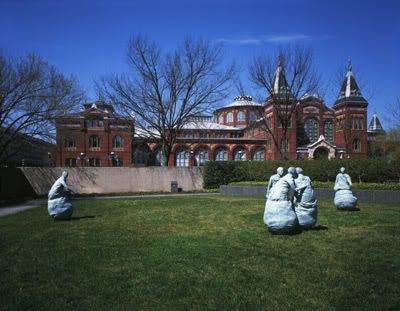
"The Last Conversation Piece" Bronze Sculpture by Juan Munoz (1994-1995)
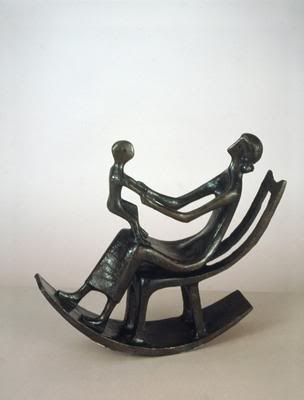
"Rocking Chair No. 2" Bronze Sculpture by Henry Moore (1950)
Should a meteorite strike the Hirshhorn Museum and Sculpture Garden in Washington, D.C. Chad Van Hoesen chose to save Henry Moore’s 1950 bronze sculpture, Rocking Chair No. 2 and Nancy Johnson selected a bronze sculpture created in 1994-95 by Juan Munoz entitled, The Last Conversation Piece. First, Nancy will discuss her piece and then Chad will address the reasons for saving his.
My first impression of The Last Conversation Piece was that five figures that make up the scene reminded me of the roly-poly Weeble figures that sat in the Fisher-Price airplanes and buses. No matter how often you knocked them down, they always got up. In case of a disaster, I would hope that we could do the same.
This grouping invites you to participate by eavesdropping on the conversation or perhaps quarrel among the three central figures which are grouped together. You sense an antagonistic atmosphere as though two of the figures are ganging up on the third. Munoz relays this information by the positioning of his figures. One figure has its arm extended into the chest of another. Another figure is leaning forward as if he is yelling at the same figure. There are two secondary figures located some distance from the central three figures. As one might expect during a playground quarrel or a street brawl, these two figures seem to be coming to their aid. It is unclear whether they are making their way across the field to join the fight or to de-escalate the tension, but it is clearly human to want to help.
While this piece would be logistically difficult to save, I think that Munoz’s grouping should be saved because it captures the human spirit. It represents the frustrating moments in our lives and our need to express our frustrations. The piece also reminds us that we are not alone. It is representative of how we deal with our conflicts, whether they international, domestic or simply personal.
Rocking Chair No. 2 is a sculpture in bronze created by Henry Moore in 1950. This piece celebrates the relationship between mother and child. The reason I choose to save this piece of artwork is because my wife just gave birth to our first child eight weeks ago today. I have been fascinated by the transformation in the both of us. We have gone from self-centered couple to Mom and Dad. We still catch ourselves marveling about the fact that we have a baby to take care of. When I look at this piece of artwork I see her rocking the baby during the night and after feeding time. It makes me pause to think about all those quiet moments that we get to spend with our new addition.
In this piece the mother and child are at play. The exaggerated curve of the chair and of the floor beneath her feet makes it look as if they are quickly rocking back and forth. The mother has her head thrown back which makes it look as if she’s laughing. I feel nothing but happiness and joy when looking at this piece. I believe that is how most parents feel when they are at play with their children. In this day and age many of us are so wrapped up in our careers that we do not take the chance to enjoy simple pleasures, like rocking our children. By saving this piece of artwork, I hope to show parents that there is joy to be found in our children.
Noticeably, each of us sees art as a powerful way to capture different aspects of human relationships. The pieces we selected to save represent the flaws and the beauty of being human.
Wednesday, October 17, 2007
Activity #9
The camera was invented in the 19th century and its use became more widespread during the industrial revolution. The use of the camera freed painters and sculptors from their traditional role of recording appearances and events (219). Pictures were now able to do this task. This essay will briefly explore some of the changes noted in artwork after the widespread use of the camera.
The use of the camera allowed artists to begin exploring the abstract and art that was not representative of real life. First, Monet led the impressionist movement. Monet used short brush strokes and painted directly onto the canvas, without sketching first. These brush strokes caused the paint to have a texture and not be smooth as was the fashion prior to photography. This also allowed him to delve into the design elements of color and light. The subject of the artwork did not necessarily take over the piece anymore, but the design allowed for the artist to make observations and it gave them a more free hand.
Next, post impressionism and expressionism came into vogue. These artworks made the elements of design even more important than during the impressionist movement. Van Gough was an artist during this period. He explored the use of color in his pieces and they no longer reflected reality.
Finally, cubism became popular. Cubism allowed artists to explore multiple perspectives in their work, a technique that could not be done using photography at the time.
The advent of the camera and its widespread use allowed artists the freedom to express what they saw in their minds eye, and not necessarily what is actually there to be seen. It allowed for design principles such as the use of color, light, and symmetry to be explored. This made art, in my opinion, more interesting.
The use of the camera allowed artists to begin exploring the abstract and art that was not representative of real life. First, Monet led the impressionist movement. Monet used short brush strokes and painted directly onto the canvas, without sketching first. These brush strokes caused the paint to have a texture and not be smooth as was the fashion prior to photography. This also allowed him to delve into the design elements of color and light. The subject of the artwork did not necessarily take over the piece anymore, but the design allowed for the artist to make observations and it gave them a more free hand.
Next, post impressionism and expressionism came into vogue. These artworks made the elements of design even more important than during the impressionist movement. Van Gough was an artist during this period. He explored the use of color in his pieces and they no longer reflected reality.
Finally, cubism became popular. Cubism allowed artists to explore multiple perspectives in their work, a technique that could not be done using photography at the time.
The advent of the camera and its widespread use allowed artists the freedom to express what they saw in their minds eye, and not necessarily what is actually there to be seen. It allowed for design principles such as the use of color, light, and symmetry to be explored. This made art, in my opinion, more interesting.
Tuesday, October 9, 2007
Midterm--Nature, A Theme in Art
The following exhibition highlights six paintings that span history beginning in the early 1600’s throughout the early 1900’s. The theme of these works is nature. These pieces were chosen because they all highlight water in their landscape. Each artist has a unique perspective on how water is depicted in their work. When nature is portrayed through art it allows the audience to see the world through the eyes of the artist. Nature is sometimes portrayed literally and sometimes in the abstract, meaning it is interpreted through the eyes of the artist. This exhibition will explore the theme of nature in these six works by reviewing some of the design elements and principles that were utilized by the artist to highlight their theme, nature.
Jan Brueghel the Elder
River Landscape, 1607
Oil on Copper
National Gallery of Art, Washington, DC
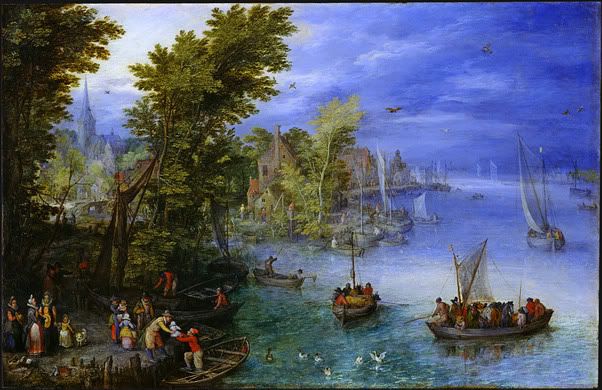
In 1607, Jan Brueghel the Elder used oil on copper to create “River Landscape”. The light (90) in this work is shown coming through the dark sky in the upper left corner. This is evident through the break in the clouds and the light shining on the water in the front right of the painting. The area in front of the light is shown in detail with the area behind are shown as if in a fog. This painting is also very asymmetrical (129). The weight of the work is on the left side and the right side of the work is much less busy and painted in lighter colors.
Richard Parkes Bonington
The Grand Canal, 1826/1827
Oil on Canvas
National Gallery of Art, Washington, DC
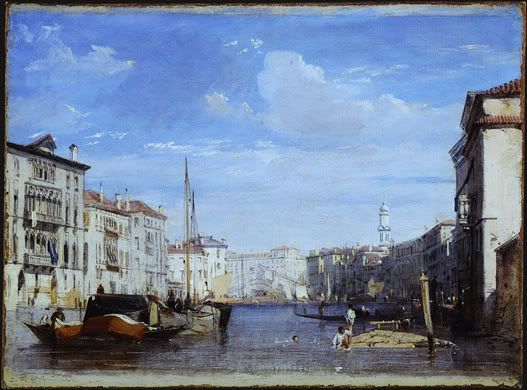
“The Grand Canal” is an oil on canvas piece created in 1826/1827 by Richard Parkes Bonington. He utilized several visual and design elements to create this beautiful scene. The first is atmospheric perspective (113). This is a technique that is “based on the observation that distant objects appear less distinct, paler, and bluer than nearby objects due to the way moisture and the intervening atmosphere scatters light”. In this painting the buildings in the back of the work take on a light blue tint from the sky making them appear far away in the distance. Light (90) is another element utilized by the artist. In this work, the buildings on the right side of the painting are shaded on the front because the light in the painting is shining from high in the sky on the right. This is also obvious because the buildings on the left are bathed in light. Scale (136) is evident in this work because the buildings start out large at the front of the painting and as the view looks toward the back of the canal the buildings get smaller. Scale is the size in relation to normal size. The use of scale draws the viewers’ attention down the canal.
Auguste Renoir
The Blue River, c. 1890/1900
Oil on Canvas
National Gallery of Art, Washington, DC
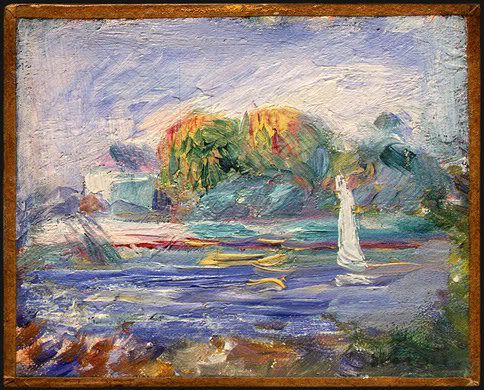
“The Blue River” was created with oil on canvas around 1890-1900 by Auguste Renoir. When first looking at this piece, the eye is drawn to the statute in the water. Renoir emphasized (134) this statue by painting it pure white. This is the only pure white in the work. He also used an open palette. A palette describes the range of colors used in a work and an open palette is one in which all colors are permitted (98, 586). This work utilizes yellow, red, blue, and green as well as various shades and tints of them. The work is also a-symmetrical (129). This is evident because the right side of the work contains most of the visual weight. Visual weight refers to the apparent “heaviness” or “lightness” of the forms arranged in a composition, as gauged by how insistently they draw the viewers’ eyes (125). The viewers’ eyes are drawn to the statue on the right side of this work.
Claude Monet
The Japanese Footbridge, 1899
Oil on Canvas
National Gallery of Art, Washington, DC
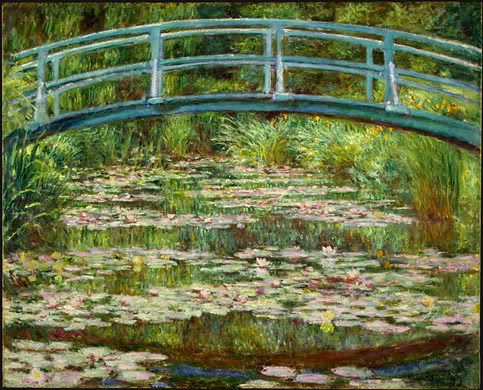
Claude Monet created “The Japanese Footbridge” in 1899 with oil on canvas. Color is a major element of this work. First, the colors used in this work, shades of green, yellow, blue and red, are analogous colors (97). These are a combination of colors adjacent to one another on the color wheel. The viewer sees these colors throughout the work. Monet also used color to highlight the focal point (134) of the work. A focal point is created when one area of a work is emphasized. It is easy to see the bridge is the focal point because of the use of the color blue. This is the only place in the work where blue is utilized. The water is not even blue, it is used to reflect the grasses and the colors in them. Finally, the grasses, bridge, and water are all painted in the same portions as they would be in reality, meaning the scale (136) is the same as one would see in nature.
Maurice de Vlaminck
Tugboat on the Seine, Chatou, 1906
Oil on Canvas
National Gallery of Art, Washington, DC

In 1906, Maurice de Valminck created “Tugboat on the Seine, Chatou” utilizing oil on canvas. He used primary colors (red, yellow and blue), as well as secondary colors (orange and green) to create this work (95). By using all these colors it is apparent that he was using an open palette like Renoir did when creating this piece. Movement (84) is created in this work by the heavy brush strokes and their direction in the water. The water is portrayed running around the front of the second boat which shows that the boats are moving upstream from the way the water is running.
John Marin
Middle of Atlantic, 1909
Watercolor on Wove Paper
National Gallery of Art, Washington, DC
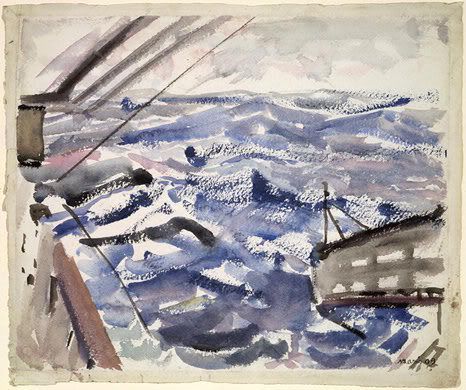
John Marin used watercolor on wove paper in 1909 to create “Middle of the Atlantic”. This piece is created solely with black and blue paint. These are cool colors (95). This color choice makes the work appear melancholy. The sky is grey and the water is dark blue and black and painted to make the water appear choppy. The view might assume that there is a storm brewing in this painting. Marin used a restricted palette (98), which is the use of few colors in a work. He only uses the two colors and then he mixes them to get various tints of blue, black and grey.
Jan Brueghel the Elder
River Landscape, 1607
Oil on Copper
National Gallery of Art, Washington, DC

In 1607, Jan Brueghel the Elder used oil on copper to create “River Landscape”. The light (90) in this work is shown coming through the dark sky in the upper left corner. This is evident through the break in the clouds and the light shining on the water in the front right of the painting. The area in front of the light is shown in detail with the area behind are shown as if in a fog. This painting is also very asymmetrical (129). The weight of the work is on the left side and the right side of the work is much less busy and painted in lighter colors.
Richard Parkes Bonington
The Grand Canal, 1826/1827
Oil on Canvas
National Gallery of Art, Washington, DC

“The Grand Canal” is an oil on canvas piece created in 1826/1827 by Richard Parkes Bonington. He utilized several visual and design elements to create this beautiful scene. The first is atmospheric perspective (113). This is a technique that is “based on the observation that distant objects appear less distinct, paler, and bluer than nearby objects due to the way moisture and the intervening atmosphere scatters light”. In this painting the buildings in the back of the work take on a light blue tint from the sky making them appear far away in the distance. Light (90) is another element utilized by the artist. In this work, the buildings on the right side of the painting are shaded on the front because the light in the painting is shining from high in the sky on the right. This is also obvious because the buildings on the left are bathed in light. Scale (136) is evident in this work because the buildings start out large at the front of the painting and as the view looks toward the back of the canal the buildings get smaller. Scale is the size in relation to normal size. The use of scale draws the viewers’ attention down the canal.
Auguste Renoir
The Blue River, c. 1890/1900
Oil on Canvas
National Gallery of Art, Washington, DC

“The Blue River” was created with oil on canvas around 1890-1900 by Auguste Renoir. When first looking at this piece, the eye is drawn to the statute in the water. Renoir emphasized (134) this statue by painting it pure white. This is the only pure white in the work. He also used an open palette. A palette describes the range of colors used in a work and an open palette is one in which all colors are permitted (98, 586). This work utilizes yellow, red, blue, and green as well as various shades and tints of them. The work is also a-symmetrical (129). This is evident because the right side of the work contains most of the visual weight. Visual weight refers to the apparent “heaviness” or “lightness” of the forms arranged in a composition, as gauged by how insistently they draw the viewers’ eyes (125). The viewers’ eyes are drawn to the statue on the right side of this work.
Claude Monet
The Japanese Footbridge, 1899
Oil on Canvas
National Gallery of Art, Washington, DC

Claude Monet created “The Japanese Footbridge” in 1899 with oil on canvas. Color is a major element of this work. First, the colors used in this work, shades of green, yellow, blue and red, are analogous colors (97). These are a combination of colors adjacent to one another on the color wheel. The viewer sees these colors throughout the work. Monet also used color to highlight the focal point (134) of the work. A focal point is created when one area of a work is emphasized. It is easy to see the bridge is the focal point because of the use of the color blue. This is the only place in the work where blue is utilized. The water is not even blue, it is used to reflect the grasses and the colors in them. Finally, the grasses, bridge, and water are all painted in the same portions as they would be in reality, meaning the scale (136) is the same as one would see in nature.
Maurice de Vlaminck
Tugboat on the Seine, Chatou, 1906
Oil on Canvas
National Gallery of Art, Washington, DC

In 1906, Maurice de Valminck created “Tugboat on the Seine, Chatou” utilizing oil on canvas. He used primary colors (red, yellow and blue), as well as secondary colors (orange and green) to create this work (95). By using all these colors it is apparent that he was using an open palette like Renoir did when creating this piece. Movement (84) is created in this work by the heavy brush strokes and their direction in the water. The water is portrayed running around the front of the second boat which shows that the boats are moving upstream from the way the water is running.
John Marin
Middle of Atlantic, 1909
Watercolor on Wove Paper
National Gallery of Art, Washington, DC

John Marin used watercolor on wove paper in 1909 to create “Middle of the Atlantic”. This piece is created solely with black and blue paint. These are cool colors (95). This color choice makes the work appear melancholy. The sky is grey and the water is dark blue and black and painted to make the water appear choppy. The view might assume that there is a storm brewing in this painting. Marin used a restricted palette (98), which is the use of few colors in a work. He only uses the two colors and then he mixes them to get various tints of blue, black and grey.
Wednesday, October 3, 2007
Activity #5
Artwork is created for a reason, and the reason that an artist chooses to do a particular work will tie to a theme. These themes vary from secular, to political, human experience, and historic to name a few. This essay will discuss the themes utilized by Andy Warhol when he created “Green Marilyn” a silkscreen on synthetic polymer paint on canvas in 1962, and by Gilbert Stuart in 1795 when he created “George Washington” using oil on canvas.
The theme of “Green Marilyn” is the Human Experience (69). It was created soon after the death of Marilyn Monroe. Warhol tended to paint objects that were currently en vogue with popular culture and Marilyn Monroe was very famous. The work was probably created to pay homage to her life at a time that the entire country and some of the world was mourning her death. Color plays an important role in this composition. Warhol uses complementary colors in this artwork to highlight Monroe’s features. The background for this work is a shade of green while her lips are red. These two colors are complementary, harmonies involving colors directly opposite one another on the color wheel (97). Also, her hair is very pure yellow which makes it very intense (96). The use of intense, complementary colors helps to place emphasis (134) to the beautiful features that make up Marilyn Monroe’s face.
I initially thought the theme for “George Washington” was the Human Experience, but after further thought, I think the theme is Politics and Social Order (57). “George Washington” was created in 1795, four years before the death of the President. He was President of the United States at the time of the painting which made him a popular subject. This painting shows him as a very distinguished individual, as fitting his public office. It is very dark and portrays the President as very stoic. This does not humanize him to the populace, but rather makes him appear unapproachable. Color is used to emphasis his face. The vast majority of the work is made using black, but his face is emphasized by the use of hues (96) of red. This also lightens up the work around the face which draws the viewer’s attention. The artist also highlights the President’s face with the use of implied lines (86). Stuart uses shading to make these implied lines, the further from the face, the more the lines and background blur together. The expression on the face is very stoic, this again plays into the theme of Politics and Social Order, because it makes Washington appear Presidential and not common.
The theme of “Green Marilyn” is the Human Experience (69). It was created soon after the death of Marilyn Monroe. Warhol tended to paint objects that were currently en vogue with popular culture and Marilyn Monroe was very famous. The work was probably created to pay homage to her life at a time that the entire country and some of the world was mourning her death. Color plays an important role in this composition. Warhol uses complementary colors in this artwork to highlight Monroe’s features. The background for this work is a shade of green while her lips are red. These two colors are complementary, harmonies involving colors directly opposite one another on the color wheel (97). Also, her hair is very pure yellow which makes it very intense (96). The use of intense, complementary colors helps to place emphasis (134) to the beautiful features that make up Marilyn Monroe’s face.
I initially thought the theme for “George Washington” was the Human Experience, but after further thought, I think the theme is Politics and Social Order (57). “George Washington” was created in 1795, four years before the death of the President. He was President of the United States at the time of the painting which made him a popular subject. This painting shows him as a very distinguished individual, as fitting his public office. It is very dark and portrays the President as very stoic. This does not humanize him to the populace, but rather makes him appear unapproachable. Color is used to emphasis his face. The vast majority of the work is made using black, but his face is emphasized by the use of hues (96) of red. This also lightens up the work around the face which draws the viewer’s attention. The artist also highlights the President’s face with the use of implied lines (86). Stuart uses shading to make these implied lines, the further from the face, the more the lines and background blur together. The expression on the face is very stoic, this again plays into the theme of Politics and Social Order, because it makes Washington appear Presidential and not common.
Monday, October 1, 2007
Subscribe to:
Posts (Atom)
